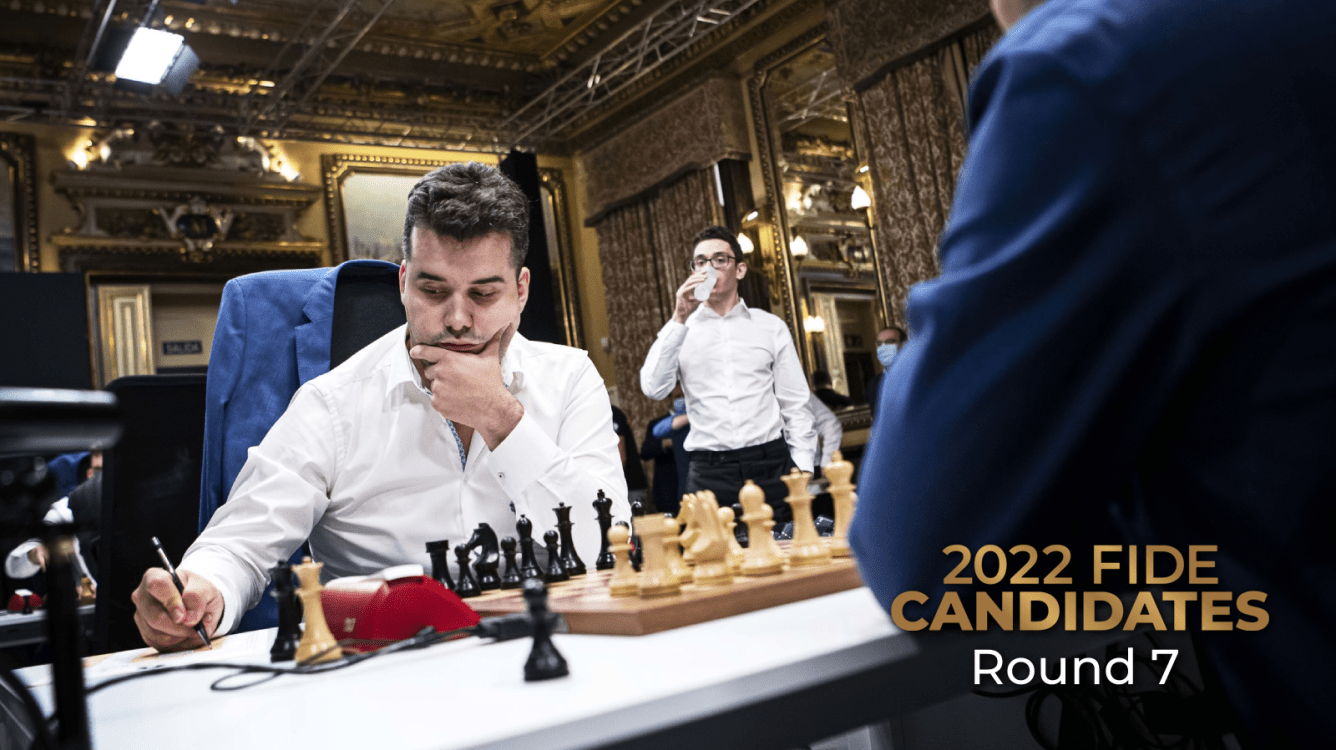
Nepomniachtchi, Caruana Win Again To Extend Lead On Field
In round seven of the 2022 Candidates Tournament, GM Ian Nepomniachtchi won his fourth game of the event but nevertheless only leads by half a point as GM Fabiano Caruana responded by scoring a win of his own.
The Russian tournament leader took down GM Richard Rapport as the Hungarian sidestepped a home-prepped draw, while Caruana took a pawn and eventually converted his advantage against GM Teimour Radjabov.
How to watch the 2022 Candidates Tournament
Coverage of round 7 begins on Saturday, June 25 at 6 a.m. Pacific, 9 a.m. Eastern, and 15:00 Central Europe. You can watch the 2022 Candidates live on Chess.com/TV and on our Twitch, or catch all our live broadcasts on YouTube.com/ChesscomLive. You can also keep up with all the details here on our live events platform.
In the previous Candidates Tournament, the action was halted and the players were sent home after seven rounds. This year, the players enjoyed a rest day after round six, and they returned with determined attitudes to leave no opportunity unexplored.
Rapport-Nepomniachtchi 0-1
Undoubtedly, Nepomniachtchi was happy to jump to the same kind of start as in the 2020-2021 Candidates tournament, leading the tournament with 4.5/6. He has had a bit of luck where it was needed but has generally played well, irrespective of the criticism launched at him and the rest of the participants by former World Champion GM Vladimir Kramnik in an online interview.
The boy wonder of creative chess, Rapport, has played combative chess, yet has been rewarded with six draws, quite unusual for someone who rocks the boat as much as he does.
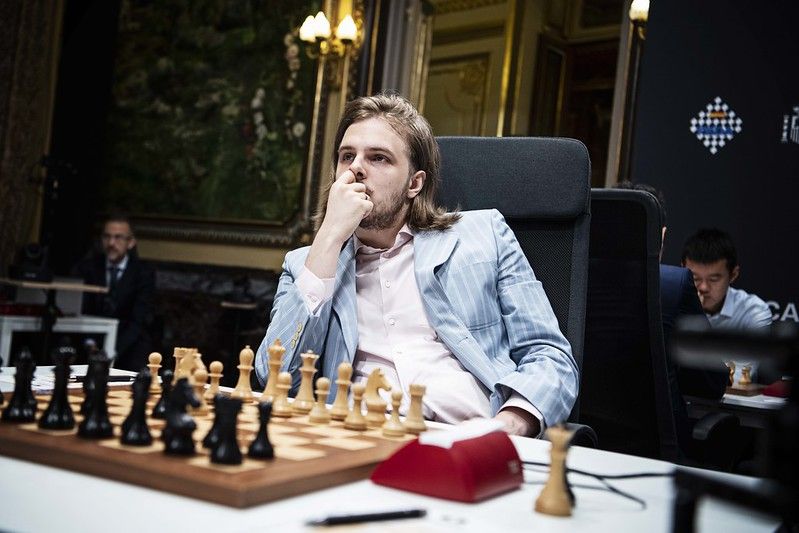
In today's game, the Russian whipped another Petroff on the board. Although not admitting too much of anything in the post-game interview with one half of the commentator duo here on Chess.com, IM Danny Rensch, it would be safe to assume that he is still fully relying on the work he did ahead of the world championship match against GM Magnus Carlsen last year. His play was blazingly fast and confident despite Rapport playing the rather obscure 9.Qb3 instead of any of the four main lines (9.Nc3, 9.Re1, 9.cxd5, and 9.Qc2) and some other minor options that have also seen more action than Rapport's choice.
Rather than accepting that the b7-pawn needed protection, Nepomniachtchi welcomed the Hungarian's queen first to eat the pawn on b7 and then the rook on a8. In return, Black played 14...Bh3!.
This is an invitation to a draw with checks on g6 and e4, something that had been played in a couple of lower-level email games three years ago.
Fully knowing that he had been caught in Black's intricate web of world championship-level home preparation, Rapport thought for a while, took one repetition, and then to everyone's surprise decided that a draw is good, but playing chess is better. Co-commentator GM Robert Hess stated: "This is why every tournament organizer should invite Rapport to their tournaments." Even if Rapport is not always rewarded for his effort, it is hard to disagree with Hess' statement.
White still had another option to draw but ultimately went down the course that he had laid for himself, playing for the win, irrespective of the consequences. This led to a position where he had two rooks vs queen, each with a knight, a bishop, and five pawns, something that on the surface sounds favorable for White, but with a vulnerable king, the equation is not so simple anymore.

As some will remember, the last time Nepomniachtchi played with a queen against two rooks, the game was a rather lengthy affair and ended up costing him the world championship.
Last time @lachesisq had a queen for two rooks we all lost 8 hours of our lives#FIDECandidates pic.twitter.com/ghRup8CpKS
— Mike Klein (@ChessMike) June 25, 2022
Unfortunately for Rapport, the pain from his decision-making soon started making its presence known, as his position slid from about equal to worse to clearly worse to lost in a matter of a dozen moves. When the knights were exchanged, White's open king and weak h-pawn decided the game in Nepomniachtchi's favor.
Annotations by GM Rafael Leitao.
An interesting coincidence is that in his last two wins, it has been h-pawns that have helped decide the games; against Duda, the h7-pawn acted as both a shield and harasser of Black's king, while Rapport's resistance ended shortly after the black h-pawn made it to h3.
Duda-Nakamura ½-½
As is the custom in many top tournaments, the rounds frequently start with a guest making the ceremonial first move, and today was no exception. However, despite telling her that GM Jan-Krzysztof Duda wanted to play 1.d4, Benedicte Westre Skog of Norway Chess played 1.e4, but the pawn was quickly returned to its original square and 1.d4 was put on the board.
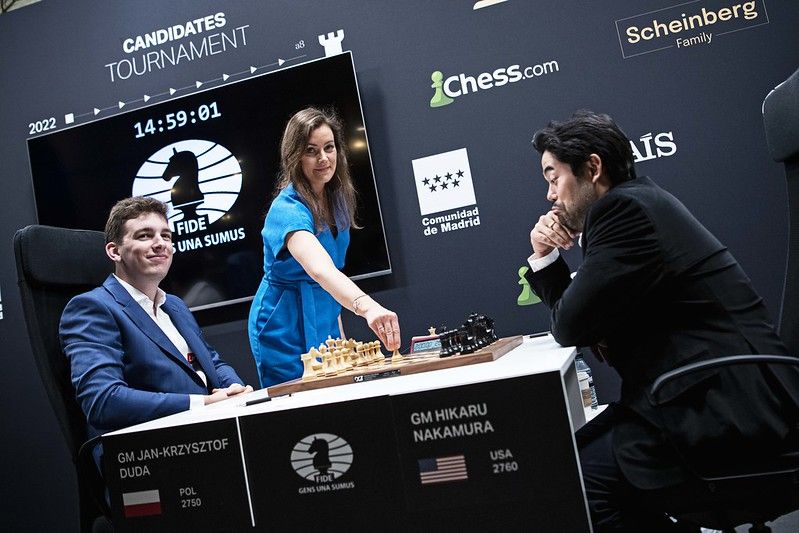
After this initial surprise, the opening choices by both players were rather predictable. GM Hikaru Nakamura used the Nimzo-Indian Defense as he had against GM Alireza Firouzja earlier in the tournament. Duda responded by playing a line he has used several times before: 4.e3 and 5.Bd3, but rather than his normal 6.Nf3, he went for 6.Nge2, a line that Nakamura used to play himself.
On the 11th move, Nakamura departed from his previous games by playing the unusual 11...Nce7, trying to block the d5-pawn. He followed up with a very committal plan of playing ...f7-f5 to stop White's mating threats on h7.
This, however, allowed White to change the pawn structure favorably, leaving him with a potential strong knight vs. a potentially very bad bishop, something Hess was very concerned about for Black.
Position after 17...Rae8
Nakamura, however, was not overly concerned about this situation, believing that White would not be able to achieve his desired set-up. Whether this made Nakamura relax more than necessary is anyone's guess because, on move 20, he played the slightly inaccurate 20...Bc6?! instead of the more active 20...Ba4!? and then followed it up with the erroneous 22...g6?, which could have become a costly mistake.
Duda, however, not realizing that this was the crucial moment of the game, played a move that Nakamura later characterized as a positional blunder: 23.b4?, which lets Black's bishop out of its cage and go to a4 with possibilities of later putting it on c4, preventing White from becoming active. Instead, 23.a4! followed by 24.b3 would have given White a clear positional advantage.

This mistake lit a candle to Nakamura's hopes of possibly playing for more than half a point, but Duda soon doused a bucket full of water on that little candle and efficiently traded off the pieces.
On move 40, the players agreed upon a draw at Nakamura's proposal.
Annotations by GM Rafael Leitao.
Caruana-Radjabov 1-0
One player won the last time he sat at the board while his struggling opponent has not won a game since 2019. A foregone conclusion? Probably not. But Radjabov, well aware of the ridiculousness of the situation, seemed ready for desperate measures.
Rather than playing his usual solid stuff against Caruana's 1.e4, he whipped out a line that Nakamura characterized as a "random Sicilian". The line in question is the so-called O'Kelly Sicilian which arises after 1.e4 c5 2.Nf3 a6, something the English IM Andrew Martin recently released a book about (Everyman Chess 2022).
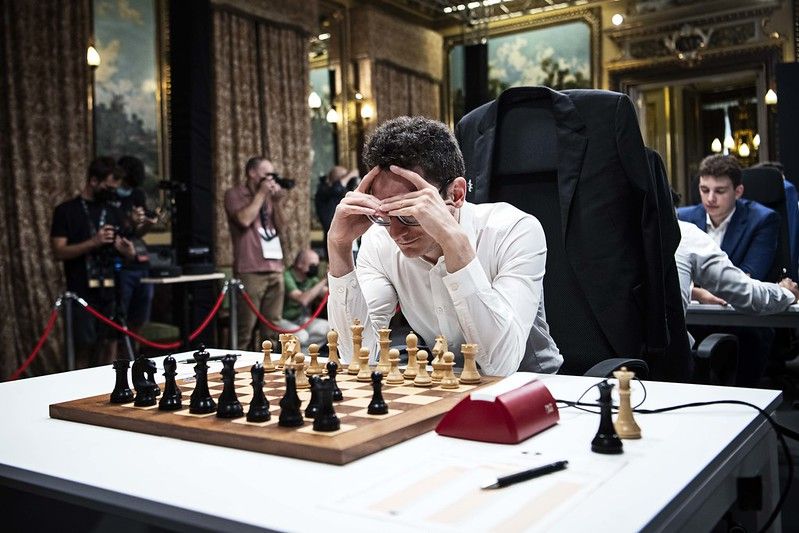
The main idea behind Black's second move is that 3.d4 is not a good idea (despite being the most common move amongst players rated below 2200!) because of 3...cxd4 4.Nxd4 e5, when White's knight cannot jump to b5. This, of course, is not news to Caruana. He went for one of the most frequently recommended lines, 3.c4, which aims to take the play into a Maroczy-style structure that should favor White.
By the way, if Martin had hoped for some free advertising for his book by this game, it became clear on move six that this was not to be when Radjabov hammered the sharp pawn sacrifice 6...d5 on the board (Martin recommends 6...d6).
Radjabov's risky decision-making did not end there. Rather than playing the reasonable 13...0-0, he instead castled queenside, which made the commentators agree on the fact that Radjabov was playing for two results: losing or drawing!
However, when Caruana did not follow up accurately, Black had some drawing chances based on the presence of opposite-colored bishops and a doubled pawn for White.
After having been put Caruana's technical meat grinder, Radjabov missed some minor chances to complicate matters for the American. In the end, with pawns racing to be queened on opposing, it was White who predictably pulled the longest straw.
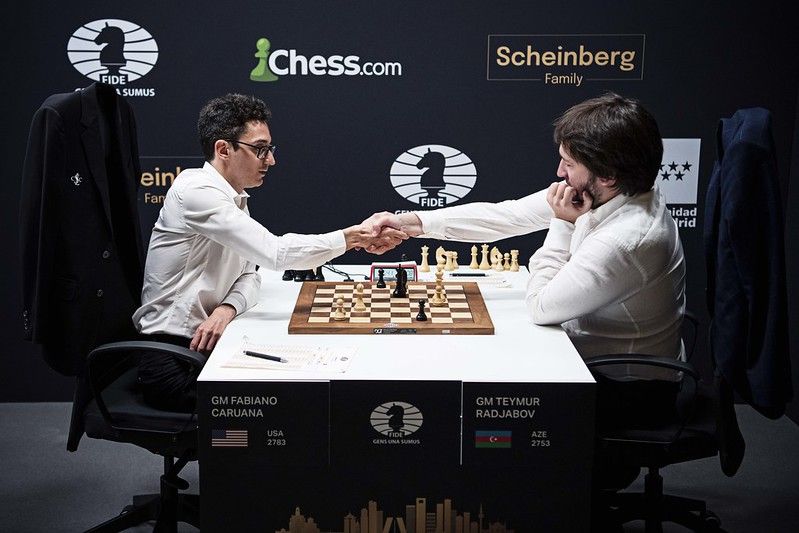
A key win for Caruana, keeping him within striking distance of Nepomniachtchi.
The first half of the Candidates is in the books, and I have to say the seventh round was a pretty disappointing one for the fans. Five guys are still winless, the tournament clearly only has two players with any serious hope of winning, and finally, I was really unhappy to see that risk-taking was not rewarded. Both Rapport and Radjabov, in their games against the leaders, took much riskier decisions than what I would expect from them, or what would seem objectively correct. But that's what you need to do when trailing in a tournament when it is basically winner takes all. Caissa spat in their faces as Caruana and Nepo both more or less cruised to victory without ever having to worry about counterchances.
Ding-Firouzja ½-½
The world number two, GM Ding Liren, had undoubtedly hoped to play more of a role in the tournament than had been the case thus far, but like in the previous Candidates tournament, he is struggling to find the way to the full points. However, his struggles were nothing compared to that of Firouzja, who most people, including the world champion, had hoped might win the event. But after six rounds, he was in last place and facing Ding; a win with the black pieces did not seem like a reasonable expectation.
When Ding then dished up another English Opening, his mood could not have been the best.

The French-Iranian grandmaster tried to stir things up with an unusual line but seemed to end up with an unexciting position where only White could have the better chances. Nevertheless, Black continued to push for the initiative, not settling for merely trying to equalize.
However, Ding played careful chess, exchanging when it made sense and avoiding the exchanges when they were less interesting, but off the board was where most of the pieces found themselves.
Despite the game lasting 54 moves, the evaluation bar seemed locked in the middle and the engines tell your humble reporter that the evaluation was never more than +/- 0.10 at any given time, which means that the game was a very correct draw. Not what any of the players needed, but chess can be unforgiving at times.
Annotations by GM Rafael Leitao.
Round 7 Standings
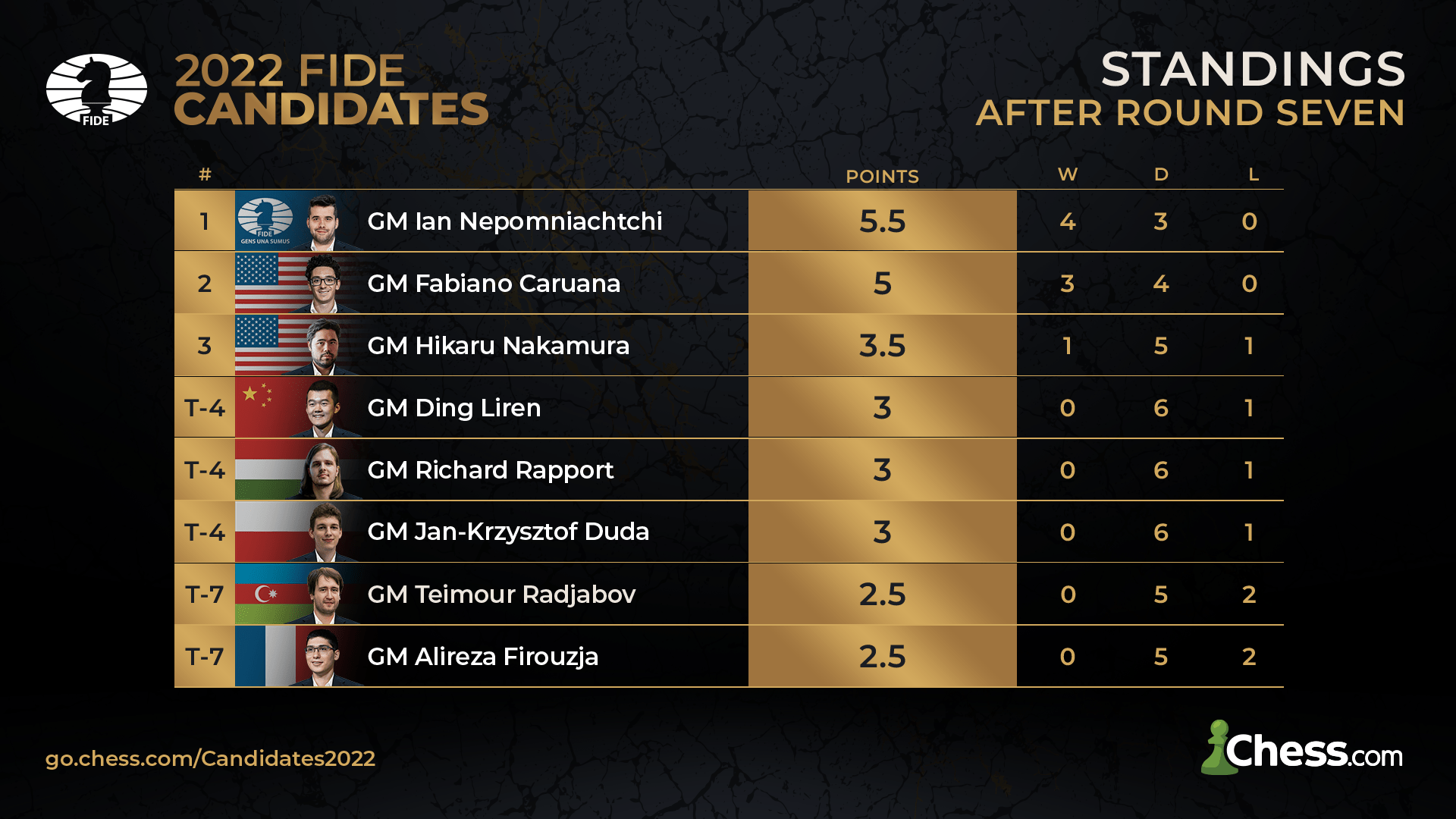
Round 8 Pairings
| Round 8 | 6.26.2022 | 6 a.m. PT/15:00 CEST |
| Rapport | - | Duda |
| Nepomniachtchi | - | Ding |
| Nakamura | - | Caruana |
| Firouzja | - | Radjabov |
Previous coverage:
- Nepomniachtchi, Caruana Pick Up Wins In Spectacular 6th Round
- Nepomniachtchi Dodges Bullet, Maintains Lead In Madrid
- Nepomniachtchi Beats Firouzja, Storms To Sole Lead
- Impressive Defense By Nakamura On Day Of Draws
- Nakamura Bounces Back, Grinds Down Radjabov As Rivals Draw
- Caruana, Nepomniachtchi Win To Set Up Clash Of Leaders
- Caruana To Play His 4th Candidates: 'I Don't Actually Look At The Prize Fund'
- Which Candidate Has The Best Post-Pandemic Performance Rating
- Who Will Win The Candidates: The Case For Each Player
- Who Will Win The 2022 Candidates?
- 2022 FIDE Candidates Tournament: All The Information



